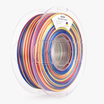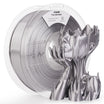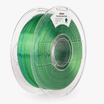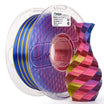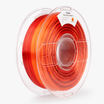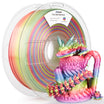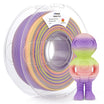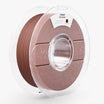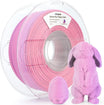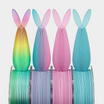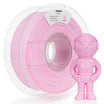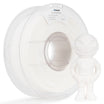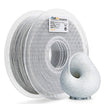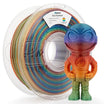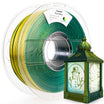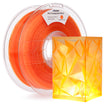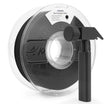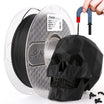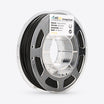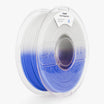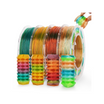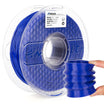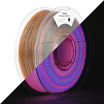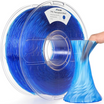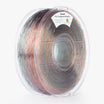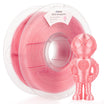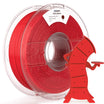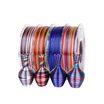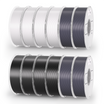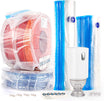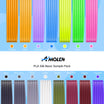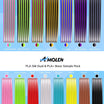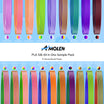Picking the right filament for a 3D printing project can feel complicated, but it’s one of the keys to getting a great result. This choice goes beyond just color—the material itself affects how a part performs, how strong it is, and how it holds up over time. Using a material that isn't right for the job often leads to failed prints or parts that don't last, which is a waste of both time and plastic. This guide simplifies the decision by breaking down how to match a filament's properties to your project's needs and your printer's limits.
Step 1: Answer Four Key Questions About Your Project
Before picking a filament, think about what your printed part actually needs to do. Answering a few questions about its job will point you directly to the right type of material.
1. Does it need to be strong, tough, or flexible?
First, consider the physical forces the part will handle. Will it hold weight and need to be stiff? A structural bracket, for instance, must be rigid to keep from bending. In contrast, a tabletop model has no real strength requirement. Will the part be dropped or take impacts? A drone frame needs to be tough enough to survive a crash, whereas a decorative vase does not. Finally, does it need to bend? A phone case should be flexible so it can be fitted onto a phone, requiring a rubber-like material that a rigid part could not provide.
2. Will it be exposed to heat?
Heat can easily ruin a 3D-printed part. Consider if your object will sit in a hot car, be placed near a running motor, or need to hold hot water. All plastics have a temperature where they begin to soften and warp. If you expect the part to get hot, you must choose a filament with high heat resistance to ensure it keeps its shape.
3. How should it look and feel?
Think about the final appearance and texture you want. Do you need a surface that is glossy, matte, or smooth? Your plans for finishing the part also matter. If you want to sand, paint, or glue your print, some materials are much easier to work with than others. Your choice will also be narrowed down if you need specific colors, transparent parts, or special effects like those that look like silk, wood, or metal.
4. Will it be used outdoors, with food, or around chemicals?
Finally, think about any special conditions the part will face.
- Outdoors: If a part is used outside, it needs to be UV resistant. Otherwise, sunlight will quickly make the plastic brittle and faded.
- Food Contact: For any part that will touch food, you must use a filament that the manufacturer has certified as food-safe. The printing process itself also has to be clean, which includes using a food-grade stainless steel nozzle to prevent lead contamination from standard brass nozzles.
- Chemicals: If the part will be near oils, solvents, or other chemicals, you need to pick a material specifically known to resist them.
Step 2: Start with the Three Most Common Filaments
Most 3D printing projects can be handled perfectly by one of these three standard materials. It's best to get familiar with them first.
PLA: Best for Beginners and Visual Models
For most people, PLA (Polylactic Acid) is the best filament to start with because it's the easiest to print. It's the right choice for decorative objects, models, and simple prototypes that won't be subjected to a lot of physical force.
- Pros: PLA is very reliable and doesn't warp easily. It doesn't require a heated bed (though using one helps) and produces no harsh fumes. For those seeking rapid and reliable printing results, exploring high-speed PLA filament options can make a significant difference, especially for large or time-sensitive projects.
- Cons: The main downsides are that it's brittle, meaning it's more likely to snap than bend when stressed. It also has very poor heat resistance and will permanently deform at temperatures above 60°C (140°F), so it cannot be used for parts left in a hot car or near any heat source.
While PLA is a great starting point, understanding the different types of filament available will help you choose the right material for any project.
PETG: For Stronger, More Durable Parts
When you need a part that is stronger and more durable than PLA can provide, PETG (Polyethylene Terephthalate Glycol) is the next logical choice. It offers a great balance of strength, heat resistance, and ease of use, making it ideal for printing functional items like mechanical parts, brackets, and protective covers. Many brands also offer food-safe versions.
- Pros: It's significantly tougher than PLA and can handle higher temperatures.
- Cons: Printing with PETG can be a little tricky. It tends to leave fine plastic "strings" on prints. It also readily absorbs moisture from the air (it's hygroscopic), which causes print quality issues, so spools must be stored in a dry box. A heated print bed is required.
ABS: For High-Impact, High-Temperature Parts
ABS (Acrylonitrile Butadiene Styrene) is an industrial-grade plastic known for its toughness and ability to withstand high temperatures. It’s the same material used for LEGO bricks and many car interior parts. Use it when you need to print very strong, durable parts like electronics enclosures or components that will be near heat. A unique benefit is that its surface can be smoothed with acetone vapor to achieve a glossy, professional finish.
- Pros: Very strong, durable, and has high heat resistance.
- Cons: ABS is difficult to print successfully. It shrinks as it cools, which causes prints to warp severely and pull away from the print bed. To use it, two things are mandatory: 1) a heated bed that can reach at least 100°C, and 2) a printer enclosure. The enclosure is essential for keeping the air temperature stable to prevent warping and for containing the strong, potentially harmful fumes (VOCs) that ABS releases. Ensure your printing area is well-ventilated.
Step 3: Explore Common Engineering & Specialty Filaments
If PLA, PETG, and ABS don't have the specific properties your project requires, you may need to use a more specialized filament.
Flexible Filament (TPU): For Rubber-Like Parts
This rubber-like material is used for parts that need to bend and stretch, like phone cases, gaskets, or non-slip feet. TPU is very durable but can be tricky to print. You must print slowly, and it works best with a direct drive extruder, as the flexible filament can sometimes jam in other setups.
ASA: The Best Filament for Outdoor Use
Think of ASA as an outdoor-proof version of ABS. It offers the same great strength and heat resistance but adds excellent UV resistance, so it won’t become brittle or turn yellow in the sunlight. This makes it perfect for garden tools or exterior car parts. However, it is just as difficult to print as ABS and requires a printer enclosure and good ventilation.
Nylon: For Tough, Low-Friction Parts
Nylon is an excellent choice for creating very tough, slippery parts that rub against other components. It’s ideal for printing functional gears, durable hinges, and bearings. Its biggest disadvantage is that it absorbs moisture from the air extremely fast. To get a good print, you must keep Nylon in a filament dryer before and during printing.
Composite Filaments: For Special Finishes and Strength
These materials are a base plastic, like PLA, mixed with other materials. The most important thing to know is that all composite filaments are abrasive and will quickly ruin a standard brass nozzle. You must use a hardened steel nozzle to print with them.
- Carbon Fiber-Filled: Particles of carbon fiber add stiffness and strength, making parts stronger and giving them a clean, matte finish.
- Wood-Filled: Contains fine wood fibers to create parts that look and feel like wood. They can even be sanded and stained.
- Metal-Filled: Contains fine metal powder that makes parts feel heavy. After printing, they can be polished to a realistic metallic shine.
Step 4: Match the Filament to Your Setup
Finally, you need to make sure you can actually print with the filament you choose. Your printer's features, your workspace, and your budget will determine what's possible.
Your 3D Printer's Capabilities
Not all printers can handle all materials. Check if your hardware has these key features:
- Max Nozzle Temperature: Some filaments like Nylon need a hotend that can reach 250°C or higher. Check your printer's temperature limits.
- Heated Bed: You will not get a good print with ABS or ASA without a heated bed that can reach at least 100°C. This is necessary to prevent warping.
- Printer Enclosure: For materials like ABS, ASA, and Nylon, an enclosure (a box around the printer) is not optional. It traps heat to stop parts from warping and helps contain fumes.
- Nozzle Material: A standard brass nozzle will be quickly worn out and destroyed by abrasive composite filaments (wood, metal, or carbon fiber-filled). You must use a hardened steel nozzle for these materials.
- Extruder Type: Flexible filaments like TPU are much easier to print and less likely to jam if you have a direct drive extruder.
Your Workspace and Safety
Your printing space is just as important as the printer itself. For your safety, you must have good ventilation when printing with materials like ABS and ASA, as they release strong fumes that should not be inhaled. It's also crucial to protect your materials from the environment. Filaments like PETG and Nylon will absorb moisture directly from the air, which ruins print quality, so they must be kept in an airtight container or a dedicated filament dryer.
Apply The Filament Framework!
Choosing the right filament is a process of elimination. First, list your part's requirements for strength and its environment, then check what your printer can actually handle. This will point you to the simplest material that gets the job done. When you're not sure, just follow this rule: use PLA for visual models and PETG for functional parts. That simple advice covers most common printing projects.

